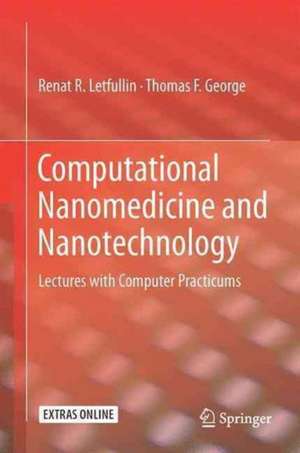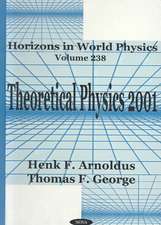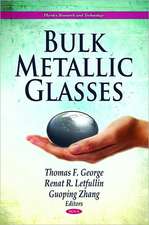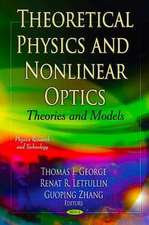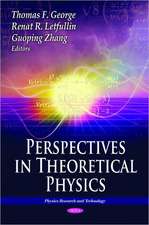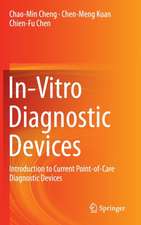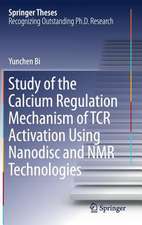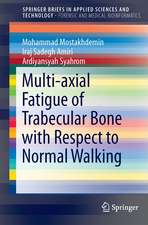Computational Nanomedicine and Nanotechnology: Lectures with Computer Practicums
Autor Renat R. Letfullin, Thomas F. Georgeen Limba Engleză Hardback – 17 feb 2017
This textbook, aimed at advanced undergraduate and graduate students, introduces the basic knowledge required for nanomedicine and nanotechnology, and emphasizes how the combined use of chemistry and light with nanoparticles can serve as treatments and therapies for cancer. This includes nanodevices, nanophototherapies, nanodrug design, and laser heating of nanoparticles and cell organelles. In addition, the book covers the emerging fields of nanophotonics and nanoplasmonics, which deal with nanoscale confinement of radiation and optical interactions on a scale much smaller than the wavelength of the light. The applications of nanophotonics and nanoplasmonics to biomedical research discussed in the book range from optical biosensing to photodynamic therapies.
Cutting-edge and reflective of the multidisciplinary nature of nanomedicine, this book effectively combines knowledge and modeling from nanoscience, medicine, biotechnology, physics, optics, engineering, and pharmacy in an easily digestible format. Among the topics covered in-depth are:
• The structure of cancer cells and their properties, as well as techniques for selective targeting of cancer and gene therapy.
• Nanoplasmonics: Lorentz-Mie simulations of optical properties of nanoparticles and the use of plasmonic nanoparticles in diagnosis and therapy.
• Nanophotonics: short and ultrashort laser pulse interactions with nanostructures, time and space simulations of thermal fields in and around the nanobioparticles, and nanoclusters heated by radiation.
• Modeling of soft and hard biological tissue ablation by activated nanoparticles, as well as optical, thermal, kinetic, and dynamic modeling.
• Detection techniques, including the design and methods of activation of nanodrugs and plasmon resonance detection techniques.
• Design and fabrication of nanorobots and nanoparticles.
• Effective implementation of nanotherapy treatments.
• Nanoheat transfer, particularly the heating and cooling kinetics of nanoparticles.
• …and more!
Each chapter contains a set of lectures in the form of text for student readers and PowerPoints for use by instructors, as well as homework exercises. Selected chapters also contain computer practicums, including Maple codes and worked-out examples. This book helps readers become more knowledgeable and versant in nanomedicine and nanotechnology, inspires readers to work creatively and go beyond the ideas and topics presented within, and is sufficiently comprehensive to be of value to research scientists as well as students.
| Toate formatele și edițiile | Preț | Express |
|---|---|---|
| Paperback (1) | 716.10 lei 38-44 zile | |
| Springer International Publishing – 3 mai 2018 | 716.10 lei 38-44 zile | |
| Hardback (1) | 721.48 lei 38-44 zile | |
| Springer International Publishing – 17 feb 2017 | 721.48 lei 38-44 zile |
Preț: 721.48 lei
Preț vechi: 759.44 lei
-5% Nou
Puncte Express: 1082
Preț estimativ în valută:
138.05€ • 144.15$ • 114.00£
138.05€ • 144.15$ • 114.00£
Carte tipărită la comandă
Livrare economică 11-17 aprilie
Preluare comenzi: 021 569.72.76
Specificații
ISBN-13: 9783319435756
ISBN-10: 3319435752
Pagini: 300
Ilustrații: XX, 682 p. 104 illus., 100 illus. in color.
Dimensiuni: 155 x 235 x 44 mm
Greutate: 1.4 kg
Ediția:1st ed. 2016
Editura: Springer International Publishing
Colecția Springer
Locul publicării:Cham, Switzerland
ISBN-10: 3319435752
Pagini: 300
Ilustrații: XX, 682 p. 104 illus., 100 illus. in color.
Dimensiuni: 155 x 235 x 44 mm
Greutate: 1.4 kg
Ediția:1st ed. 2016
Editura: Springer International Publishing
Colecția Springer
Locul publicării:Cham, Switzerland
Cuprins
1. Introduction to Nanomedicine.- 2. Introduction to Cancer Cells and Targeting.- 3. Introduction to Cancer Therapy and Detection by Plasmonic Nanoparticles.- 4. Introduction to Light-Particle Interactions.
Notă biografică
Thomas F. George is chancellor and professor of chemistry and physics at the University of Missouri–St. Louis. As chancellor, he oversees academic and administrative operations of a university with 17,000 students, 2,500 faculty and staff, 40 academic buildings and a $200 million annual operating budget. In addition, $150 million of new capital construction, renovation and landscaping on campus is taking place during 2014-16. The annual amount of philanthropic contributions during his tenure as chancellor have quadrupled to over $26 million, reaching as high as $31 million in 2014.
Chancellor George is active in the St. Louis community. He has received the Distinguished Higher Education Award from the Dr. Martin Luther King, Jr., Missouri State Celebration Commission, the Outstanding Community Service Award from the St. Louis County Branch of the National Association for the Advancement of Colored People, the Lifelong Vision Award from the Lifelong Vision Foundation of St. Louis, and the Silver Beaver Award and Good Scout Award from the Greater St. Louis Area Council of the Boy Scouts of America; and he has been named St. Louis North County Chamber of Commerce Citizen of the Year. He serves on numerous civic boards and currently is chair of the Higher Education Consortium of Metropolitan St. Louis, and he served for four years as chair of the Great Lakes Valley Conference (athletics). In addition to his role as campus and community leader and fund-raiser, Chancellor George contributes at the state and national levels, such as currently serving as vice-chair of the Council on Public Higher Education in Missouri and vice-president/treasurer of the Coalition of Metropolitan and Urban Universities (comprised of 95 institutions across the US and Canada).
Chancellor George is an active researcher in chemistry and physics, specializing in chemical/materials/laser physics and nanoscience, including nanomedicine. His work, supported by a wide variety of federal and international agencies, has led to 775 papers, 7 authored and 18 edited books, and 225 conference abstracts. He has been recognized nationally and worldwide, such as being awarded the Marlow Medal by the Royal Society of Chemistry in Great Britain and named a fellow in various professional organizations (New York Academy of Sciences, American Physical Society, Society of Photo-Optical Instrumentation Engineers, American Association for the Advancement of Science) and foundations (Dreyfus, Sloan, Guggenheim). He has been elected as a foreign member of the Korean Academy of Science and Technology, and he has held the title of visiting professor of physics at Korea University in Seoul. His research has been acknowledged by an honorary doctorate in physics (honoris causa) from the University of Szeged in Hungary. He also has received an honorary doctorate in education for locality development from PhranakhonRajabhat University in Thailand. He has been awarded the Medal of Honor from Gulf University for Science and Technology in Kuwait and the Diploma of Honour from Seinäjoki University of Applied Sciences in Finland.
An accomplished jazz pianist, Dr. George has studied with faculty at the Berklee College of Music in Boston and the Eastman School of Music in Rochester, New York. He has performed extensively in public, including recent performances at various venues in Missouri and Illinois, the University of Arkansas, Gettysburg College in Pennsylvania, Nanjing University and Northwestern Polytechnical University in China, city of Szeged in Hungary, West University of Timisoara in Romania, Gulf University for Science and Technology in Kuwait, University of Sarajevo in Bosnia, and University of Dubrovnik in Croatia, and the Cultural Club in Muscat, Oman. He has also performed in Russian Siberia.
Born in Philadelphia, Chancellor George became an Eagle Scout (with bronze, goldand silver palms) and received his high school diploma from Friends' Central School, where he earned varsity letters in soccer and wrestling. He received a bachelor of arts degree (Phi Beta Kappa) with a double major in chemistry and mathematics from Gettysburg College in Pennsylvania. He earned a master of science degree and doctor of philosophy degree in theoretical chemistry from Yale University at age 23, followed by postdoctoral appointments at MIT and UC Berkeley. Joining the faculty at the University of Rochester, he was promoted by age 29 to full professor of chemistry. He then served as dean of natural sciences and mathematics at SUNY–Buffalo, provost at Washington State University, chancellor at the University of Wisconsin–Stevens Point, and since 2003 as chancellor at the University of Missouri–St. Louis.
Dr. George has been married since 1970 to Dr. Barbara Harbach, Curators’ Professor of Music, director of the School of Fine and Performing Arts, and director of Women in the Arts at the University of Missouri-St. Louis. They are the proud owners (actually, servants) of four cats – two tortoise females (Luna and Stella) and two younger, mischievous males (Jeremiah and Jarrett).
Chancellor George is active in the St. Louis community. He has received the Distinguished Higher Education Award from the Dr. Martin Luther King, Jr., Missouri State Celebration Commission, the Outstanding Community Service Award from the St. Louis County Branch of the National Association for the Advancement of Colored People, the Lifelong Vision Award from the Lifelong Vision Foundation of St. Louis, and the Silver Beaver Award and Good Scout Award from the Greater St. Louis Area Council of the Boy Scouts of America; and he has been named St. Louis North County Chamber of Commerce Citizen of the Year. He serves on numerous civic boards and currently is chair of the Higher Education Consortium of Metropolitan St. Louis, and he served for four years as chair of the Great Lakes Valley Conference (athletics). In addition to his role as campus and community leader and fund-raiser, Chancellor George contributes at the state and national levels, such as currently serving as vice-chair of the Council on Public Higher Education in Missouri and vice-president/treasurer of the Coalition of Metropolitan and Urban Universities (comprised of 95 institutions across the US and Canada).
Chancellor George is an active researcher in chemistry and physics, specializing in chemical/materials/laser physics and nanoscience, including nanomedicine. His work, supported by a wide variety of federal and international agencies, has led to 775 papers, 7 authored and 18 edited books, and 225 conference abstracts. He has been recognized nationally and worldwide, such as being awarded the Marlow Medal by the Royal Society of Chemistry in Great Britain and named a fellow in various professional organizations (New York Academy of Sciences, American Physical Society, Society of Photo-Optical Instrumentation Engineers, American Association for the Advancement of Science) and foundations (Dreyfus, Sloan, Guggenheim). He has been elected as a foreign member of the Korean Academy of Science and Technology, and he has held the title of visiting professor of physics at Korea University in Seoul. His research has been acknowledged by an honorary doctorate in physics (honoris causa) from the University of Szeged in Hungary. He also has received an honorary doctorate in education for locality development from PhranakhonRajabhat University in Thailand. He has been awarded the Medal of Honor from Gulf University for Science and Technology in Kuwait and the Diploma of Honour from Seinäjoki University of Applied Sciences in Finland.
An accomplished jazz pianist, Dr. George has studied with faculty at the Berklee College of Music in Boston and the Eastman School of Music in Rochester, New York. He has performed extensively in public, including recent performances at various venues in Missouri and Illinois, the University of Arkansas, Gettysburg College in Pennsylvania, Nanjing University and Northwestern Polytechnical University in China, city of Szeged in Hungary, West University of Timisoara in Romania, Gulf University for Science and Technology in Kuwait, University of Sarajevo in Bosnia, and University of Dubrovnik in Croatia, and the Cultural Club in Muscat, Oman. He has also performed in Russian Siberia.
Born in Philadelphia, Chancellor George became an Eagle Scout (with bronze, goldand silver palms) and received his high school diploma from Friends' Central School, where he earned varsity letters in soccer and wrestling. He received a bachelor of arts degree (Phi Beta Kappa) with a double major in chemistry and mathematics from Gettysburg College in Pennsylvania. He earned a master of science degree and doctor of philosophy degree in theoretical chemistry from Yale University at age 23, followed by postdoctoral appointments at MIT and UC Berkeley. Joining the faculty at the University of Rochester, he was promoted by age 29 to full professor of chemistry. He then served as dean of natural sciences and mathematics at SUNY–Buffalo, provost at Washington State University, chancellor at the University of Wisconsin–Stevens Point, and since 2003 as chancellor at the University of Missouri–St. Louis.
Dr. George has been married since 1970 to Dr. Barbara Harbach, Curators’ Professor of Music, director of the School of Fine and Performing Arts, and director of Women in the Arts at the University of Missouri-St. Louis. They are the proud owners (actually, servants) of four cats – two tortoise females (Luna and Stella) and two younger, mischievous males (Jeremiah and Jarrett).
Textul de pe ultima copertă
This textbook, aimed at advanced undergraduate and graduate students, introduces the basic knowledge required for nanomedicine and nanotechnology, and emphasizes how the combined use of chemistry and light with nanoparticles can serve as treatments and therapies for cancer. This includes nanodevices, nanophototherapies, nanodrug design, and laser heating of nanoparticles and cell organelles. In addition, the book covers the emerging fields of nanophotonics and nanoplasmonics, which deal with nanoscale confinement of radiation and optical interactions on a scale much smaller than the wavelength of the light. The applications of nanophotonics and nanoplasmonics to biomedical research discussed in the book range from optical biosensing to photodynamic therapies.
Cutting-edge and reflective of the multidisciplinary nature of nanomedicine, this book effectively combines knowledge and modeling from nanoscience, medicine, biotechnology, physics, optics, engineering, and pharmacy in an easily digestible format. Among the topics covered in-depth are:
• The structure of cancer cells and their properties, as well as techniques for selective targeting of cancer and gene therapy.
• Nanoplasmonics: Lorentz-Mie simulations of optical properties of nanoparticles and the use of plasmonic nanoparticles in diagnosis and therapy.
• Nanophotonics: short and ultrashort laser pulse interactions with nanostructures, time and space simulations of thermal fields in and around the nanobioparticles, and nanoclusters heated by radiation.
• Modeling of soft and hard biological tissue ablation by activated nanoparticles, as well as optical, thermal, kinetic, and dynamic modeling.
• Detection techniques, including the design and methods of activation of nanodrugs and plasmon resonance detection techniques.
• Design and fabrication of nanorobots and nanoparticles.
• Effective implementation of nanotherapy treatments.• Nanoheat transfer, particularly the heating and cooling kinetics of nanoparticles.
• …and more!
Each chapter contains a set of lectures in the form of text for student readers and PowerPoints for use by instructors, as well as homework exercises. Selected chapters also contain computer practicums, including Maple codes and worked-out examples. This book helps readers become more knowledgeable and versant in nanomedicine and nanotechnology, inspires readers to work creatively and go beyond the ideas and topics presented within, and is sufficiently comprehensive to be of value to research scientists as well as students.
Caracteristici
Explains fundamental and advanced topics in nanomedicine and their applications, with a focus on nanophototherapy of cancer-related diseases Provides complete instructions for using simulations effectively to predict nanoscale properties for real systems Includes numerous exercises for each chapter as well as a computer practicum software developed for Maple Guides readers through both experimental and theoretical aspects of computational nanoscience Reinforces readers’ understanding of essential concepts with examples from empirical research in nanotechnology-based diagnostic and therapeutic applications in medicine
